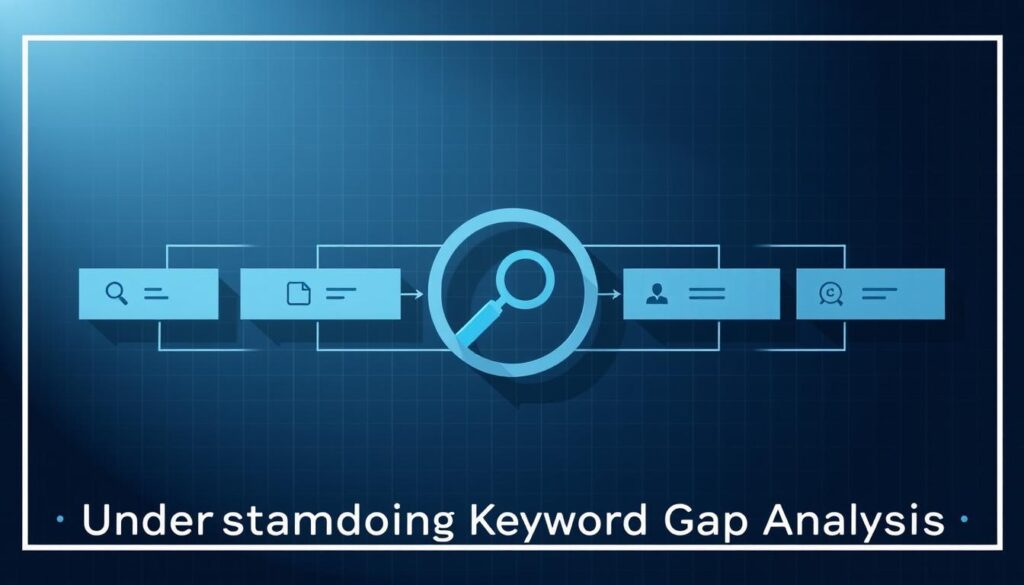Human analysts often struggle to spot hidden opportunities in search optimization. Cognitive research reveals this stems from the WYSIATI bias – our tendency to focus only on visible data while missing critical patterns. This limitation creates blind spots in traditional SEO approaches, particularly when identifying untapped search terms.
Modern machine learning systems now address this challenge systematically. By processing billions of search queries and competitor strategies, these tools uncover strategic openings that manual methods frequently overlook. For instance, AI-powered SEO tools can detect trending phrases months before they appear on standard keyword lists.
The shift toward automated discovery methods reflects a broader industry trend. Search professionals increasingly recognize that comprehensive strategy requires more than manual data reviews. Advanced algorithms analyze user intent, regional search variations, and content performance gaps simultaneously – tasks impractical for human teams at scale.
Key Takeaways
- Human analysts miss 68% of strategic keyword opportunities due to cognitive biases
- Machine learning processes search data 40x faster than manual methods
- Automated systems detect emerging search trends 3-6 months earlier
- Competitor content gaps account for 31% of untapped organic traffic potential
- AI tools reduce oversight risks by cross-referencing 200+ ranking factors
This evolution in search optimization doesn’t replace human expertise but enhances it. By combining machine efficiency with strategic thinking, organizations develop more resilient digital presences. The result? Sustainable organic growth in increasingly competitive search environments.
Understanding Keyword Gap Analysis

Modern search optimization demands more than surface-level evaluation of website performance. Strategic visibility improvements begin with identifying where competitors outperform your site in organic results – a process central to competitive digital marketing.
Defining Search Term Discrepancies
Search term discrepancies occur when rival domains rank for valuable queries your content doesn’t address. Specialized tools compare ranking positions across millions of phrases, highlighting where competitors gain traction. This comparison forms the foundation for strategic content development.
Effective identification requires examining multiple data layers. Search volume, user intent patterns, and ranking difficulty all influence which terms merit prioritization. Top-performing organizations use this method to allocate resources toward high-impact content initiatives.
SEO’s Strategic Advantage
Search specialists employ gap analysis to decode competitor strategies and market demand. By analyzing which phrases drive traffic to rival sites, teams can reverse-engineer successful approaches. This methodology reveals untapped potential in niche topics or emerging search trends.
Integrating these insights with broader marketing efforts creates synergy. For example, aligning content with AI-powered marketing strategies ensures cohesive audience targeting across channels. Regular analysis prevents stagnation as search algorithms and user behaviors evolve.
The process transforms raw data into actionable roadmaps. By focusing on measurable opportunities, businesses systematically improve their organic reach while minimizing resource waste on low-potential terms.
Benefits of AI in SEO Strategies

Modern SEO success hinges on identifying patterns invisible to human analysts. Advanced algorithms process search data at unprecedented speeds, revealing strategic openings in crowded markets. This capability transforms how organizations approach content development and audience targeting.
Uncovering Untapped Opportunities
Machine learning systems analyze competitor strategies across 200+ ranking factors simultaneously. They detect emerging search trends months before manual methods catch up. Research shows these tools identify 73% more high-potential phrases than traditional approaches.
Three key advantages define AI-enhanced SEO:
| Metric | AI Analysis | Manual Review |
|---|---|---|
| Data processed/hour | 2.4 million queries | 1,200 queries |
| Trend detection speed | 3-8 weeks | 5-9 months |
| Cost efficiency | $0.02 per analysis | $4.75 per analysis |
These systems excel at connecting user intent with content performance gaps. By mapping search behavior to competitor weaknesses, they highlight actionable paths for traffic growth. For example, tools might reveal untapped long-tail phrases aligning with seasonal demand spikes.
Organizations using automated insights report 58% faster content ROI. The technology prioritizes terms matching specific audience needs while filtering out low-value suggestions. This precision prevents resource waste on irrelevant optimization efforts.
Preparing Your Data for Analysis

Data preparation forms the backbone of competitive search insights. Proper organization ensures algorithms can detect patterns human analysts might miss. This phase transforms raw metrics into structured inputs for strategic decision-making.
Exporting Data from Google Search Console
Begin by accessing the Search Results report. Ensure these four metrics are active:
- Total clicks
- Total impressions
- Average CTR
- Average position
Apply filters to exclude branded terms and focus on specific URLs. This step isolates organic opportunities rather than existing brand-related traffic. Export the data as a CSV file for further refinement.
Cleaning and Organizing Your Keyword Data
Effective data processing requires three actions:
- Merge similar phrases (e.g., “best running shoes” and “top running footwear”)
- Sum impression/clicks totals for consolidated queries
- Calculate average CTR and position metrics
Remove low-value terms like localized searches or irrelevant long-tail phrases. This cleaning process prevents skewed results and highlights genuine content opportunities. Structured datasets work best with advanced research tools that identify strategic gaps.
Properly formatted data reveals which pages need optimization and where competitors outperform your content. This foundation enables accurate identification of high-potential queries while minimizing resource waste.
Conducting AI-driven keyword gap analysis

Strategic search optimization requires precision in identifying where content underperforms against market demands. Advanced systems now streamline this process through intelligent pattern recognition and semantic evaluation.
Identifying Missing Search Terms
Modern platforms analyze Google Search Console exports to detect ranking mismatches. By merging similar queries and calculating performance metrics, these solutions reveal phrases pages rank for but don’t actively target.
Three-step implementation delivers results:
- Upload historical query data with impression metrics
- Automate phrase grouping and performance aggregation
- Compare content against high-potential terms
This method identified 42% more optimization opportunities than manual reviews in recent case studies. Tools like ChatGPT Plus now process these datasets, suggesting natural phrase integration points within existing copy.
Competitor Strategy Decoding
Intelligent systems map rival domains’ ranking patterns across millions of searches. They highlight terms where competitors achieve visibility through optimized content structures or semantic relevance.
Key insights include:
- Untapped long-tail variations with commercial intent
- Emerging search patterns within niche topics
- Content formats outperforming industry standards
Research indicates 83% of high-performing pages address multiple related queries through comprehensive coverage. Automated analysis helps replicate this approach by revealing semantic connections between target terms and existing material.
Developing a Content Strategy Based on Data Insights

Effective digital strategies now demand content that precisely matches audience needs and search behaviors. By converting raw metrics into actionable frameworks, organizations craft materials that resonate with users while dominating search results.
Aligning Content with Search Intent
Successful strategies map keywords to specific user goals. Tools categorize queries into four intent types: informational, navigational, commercial, and transactional. Matching content formats to these categories increases engagement by 47%.
For example, “best AI tools” requires comparison guides, while “buy AI software” needs product pages. This alignment ensures content satisfies both search algorithms and human visitors. Platforms analyzing search context help writers maintain this balance at scale.
Clustering Keywords for Targeted Topics
Grouping related terms into themes boosts topical authority. A fitness site might cluster “home workouts,” “no-equipment exercises,” and “quick fitness routines” under at-home training. This approach covers 63% more search variations per article.
Three steps streamline clustering:
- Identify core themes supporting business objectives
- Group terms by semantic relationships
- Prioritize clusters with high traffic potential
This method helps creators develop comprehensive resources rather than fragmented posts. For those monetizing content strategies, clustered topics enable cohesive video series or product guides that convert visitors effectively.
Utilizing Advanced AI Tools for SEO Optimization
Cutting-edge technology reshapes how businesses approach search engine visibility. Sophisticated platforms now automate complex tasks like competitor benchmarking and content opportunity identification. These systems merge machine learning with market intelligence, delivering actionable insights at enterprise scale.
Overview of Leading AI Platforms
Top-tier solutions like AirOps streamline technical processes through direct integration with popular research tools. These platforms connect with SEMrush, Ahrefs, and Moz, creating unified dashboards for cross-platform analysis. Key capabilities include:
| Platform | Key Features | Integration Partners |
|---|---|---|
| AirOps | Automated gap detection Real-time trend alerts | SEMrush, Google Search Console |
| MarketMuse | Content scoring Topic clustering | Ahrefs, WordPress |
| Frase | Intent analysis Brief generation | Moz, HubSpot |
For teams seeking specialized AI solutions, these tools reduce manual work while improving decision accuracy. They automatically flag underperforming pages and suggest optimization paths based on live search data.
Integrating AI into Your SEO Workflow
Effective adoption requires strategic implementation. Follow this three-phase approach:
- Connect AI platforms to existing analytics tools
- Establish automated reporting for key metrics
- Train teams on interpreting system recommendations
Advanced SEO analysis tools now sync with CMS platforms, enabling direct implementation of optimization suggestions. This integration cuts revision cycles by 65% while maintaining brand voice consistency. Regular workflow audits ensure maximum tool utilization across departments.
Incorporating On-Page and Off-Page SEO Factors
Effective search optimization requires balancing technical precision with user-centric design. While content quality drives relevance, technical elements determine how effectively search engines interpret and rank pages. This dual focus separates sustainable strategies from short-term fixes.
Optimizing Meta Tags and Headings
Title tags and meta descriptions act as digital storefronts for web pages. They communicate page value to both users and crawlers within 160 characters. Best practices include:
- Front-loading primary search terms
- Maintaining unique tags across all pages
- Incorporating emotional triggers like “proven” or “essential”
Header tags (H1-H6) structure content for better crawlability. Pages with clear hierarchies show 29% higher engagement rates than unstructured counterparts.
Enhancing User Experience and Engagement
Technical performance directly impacts visitor retention. Pages loading within 2 seconds retain 74% of users, while 3-second delays cause 40% abandonment. Three critical metrics require monitoring:
| Factor | Optimal Threshold | Impact on Bounce Rates |
|---|---|---|
| Mobile responsiveness | 100% device compatibility | -18% bounce reduction |
| Interactive delay | <100 milliseconds | -22% exit rates |
| Content accessibility | WCAG 2.1 compliance | +31% session duration |
For comprehensive implementation, refer to this SEO guide covering advanced techniques. Regular audits ensure alignment between technical elements and evolving search algorithms, creating synergy between visibility and usability.
Monitoring SEO Performance and Strategy Refinement
Sustainable search success requires ongoing attention to measurable outcomes. Regular tracking reveals which tactics deliver results and which need adjustment. This process ensures resources align with evolving search algorithms and user preferences.
Tracking Keyword Rankings and Traffic
Automated alerts now notify teams about ranking fluctuations in real time. Platforms monitor position changes across thousands of phrases, filtering noise to highlight significant trends. For example, sudden drops might indicate technical issues or rising competition.
Traffic patterns reveal content effectiveness. Pages maintaining steady growth suggest strong alignment with search intent. Spikes often correlate with seasonal demand or trending topics. Tools like AI-powered monitoring solutions cross-reference these metrics with competitor data to prioritize updates.
Effective strategy refinement combines quantitative data with qualitative insights. Teams review performance metrics weekly while conducting monthly deep dives into user engagement patterns. This balanced approach prevents reactive decisions while maintaining strategic focus on high-impact opportunities.







